Abstract
The Golgi apparatus (GA) of spinal cord motor neurons is fragmented in sporadic amyotrophic lateral sclerosis (ALS), and in asymptomatic and symptomatic transgenic mice expressing the G93A mutation of the gene of the human Cu,Zn superoxide dismutase, found in certain cases of familial ALS (FALS) [Gonatas NK (1994) Am J Pathol 145 : 751–761; Mourelatos Z, et al. (1996) Proc Natl Acad Sci USA 93 : 5472–5477]. A similar fragmentation of the GA has been described in cells treated with microtubule-depolymerizing drugs, where the organelle is functional and contains both Golgi stacks and trans-Golgi network (TGN), the compartment of exit and targeting of proteins processed by the GA. To gain a better definition of the structure of the fragmented neuronal GA in ALS, four cases of sporadic ALS with numerous Bunina bodies in spinal cord motor neurons were stained with antibodies against human TGN and against the lumenal and cytoplasmic domains of MG160, a protein of the medial cisternae of the GA. The fragmented GA was stained with the three antibodies, indicating the presence of both Golgi stacks and TGN. Furthermore, the staining of the fragmented GA by the antiserum against the cytoplasmic domain of MG160 indicates that the fragmentation of the GA is not the result of a terminal and global cytoplasmic lytic event. The Bunina bodies were not stained by the anti-MG160 antibodies, suggesting that they are not derived from the GA. The perikarya of neurons with fragmented GA showed normal immunoreactivity with antibodies against the heavy neurofilament subunit and α-tubulin. However, because of the lack of appropriate antibodies the localization of proteins such as spectrin, ankyrin, centractin and others which link the microtubules with the GA were not done. The findings support the hypothesis that, in ALS, the fragmented neuronal GA is functional. Additional work with animal models of ALS may establish whether the fragmentation of the GA is a sign of early degeneration or a compensatory reaction of the injured motor neuron.
Similar content being viewed by others
Author information
Authors and Affiliations
Additional information
Received: 7 October 1997 / Accepted: 5 November 1997
Rights and permissions
About this article
Cite this article
Stieber, A., Chen, Y., Wei, S. et al. The fragmented neuronal Golgi apparatus in amyotrophic lateral sclerosis includes the trans-Golgi-network: functional implications. Acta Neuropathol 95, 245–253 (1998). https://doi.org/10.1007/s004010050794
Issue Date:
DOI: https://doi.org/10.1007/s004010050794




